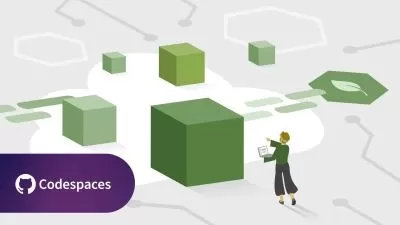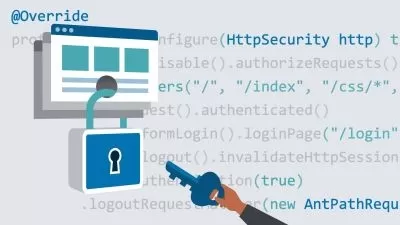Code GraphQL Application : Java Spring Boot 3 & Netflix DGS
Timotius Pamungkas
11:43:09
Description
Learn how to use Java Spring Boot 3 + Netflix DGS to build GraphQL backend : read, modify, and subscribe for data change
What You'll Learn?
- What is GraphQL and how it stands with REST API
- When to use GraphQL
- Design GraphQL schema
- Easily create GraphQL using Netflix GraphQL (DGS) Framework
- Build GraphQL backend using Java Spring Boot + PostgreSQL
- Build GraphQL resolver : query, mutation, subscription (real-time update)
- Using GraphQL client (Altair, Rest, Netflix, Apollo) for query, mutation, & subscription
- All source codes available to download
Who is this for?
More details
DescriptionLatest Update
With more than 4 hours update of the latest and greatest tech updates, and a real-life project experience, you'll feel like you've been transported to a parallel universe where GraphQL rules all. You'll learn how to:
Define GraphQL models like a boss
Craft database schemas with the precision of a samurai
Control multiple GraphQL services with the flick of a wrist
Tame database migration with Flyway, like a wild stallion
Build queries and mutations that would make Linus Torvalds nod in approval
Tackle the N+1 problem like a superhero
Use dynamic filtering, sorting, and pagination on GraphQL queries like a magician
Trace and limit complexities with GraphQL instrumentation like a detective
Validate inputs with custom validations for business rules like a judge
Upload files like a pro
Update existing data with mutations like a ninja
Combine multiple GraphQL services like a superhero team
Load data from other GraphQL and non-GraphQL services like a wizard
Solve the GraphQL N+1 problem with data loaders like a detective
Implement Apollo federation for combining multiple GraphQL services like a king
Don't miss out on the opportunity to level up your skills, impress your coworkers, and become the office GraphQL guru. Enroll now and get ready for the ride of a lifetime!
What Is Graph?
I am graph, I go to work on graph. It's everywhere, really. I have a sister. Both of us has same parents. Our mom has parents, which is our grandparents from mom's side. And so our dad, which means we have grandparents from dad's side. And together, this is he "myself" graph. Tweet something on twitter, and it's a graph. See: 8 people likes the tweet, and 3 people retweet my original tweet, so this is the graph.
What Is QL?
QL in GraphQL is shorthand for query language. If it seems familiar, you are right. SQL, or the structured query language, has the same shorthand. SQL used to read and manipulate data in database. During SQL read, we can select multiple columns as we need, from one table, or several connected tables, usually through foreign key. The same way with GraphQL. Like SQL, a single GraphQL query can return multiple columns from connected data. We can also use GraphQL to change or remove data.
So What is GraphQL?
GraphQL is a query language which uses graph concept. GraphQL is also a runtime that needs to be implemented on the backend, so the frontend application can use it as the query language.Â
To implement graphql, we need runtime frameworks, which each programming language has their own implementation. GraphQL itself is a specification, means whatever the framework, it must comply to the graphql specification, so the user can use GraphQL without even need to know what the GraphQL backend language is.
GraphQL is a service, where we need two items for creating Graphql backend. First, is the schema, which represents GraphQL structure. It is like database tables and relationships. Second is the resolver, which is logic for each field on schema to represents data. A resolver tells how and where to access certain field. For example, whether to get field's data from database, or text file.
Some says GraphQL is "RESTÂ APIÂ killer", "The next RESTÂ API", et cetera.
But what is GraphQLÂ and why facebook, netflix, github, and some large names shift their technology to GraphQL? Is it true that GraphQLÂ is "REST APIÂ killer"? Or the contrary, it is "RESTÂ APIÂ friend"?
In this course, we will learn the GraphQL fundamentals, including data types, schemas, and graphql operations. We will learn using Java Spring Boot and Netflix DGSÂ framework to easily build GraphQLÂ Java application. In this course, we will not only learn theories, but do a hands-on coding using PostgreSQLÂ as database.
Complete source code is provided for the course, so you will always stay up-to-date and have reference in case you are having difficulty (believe me, GraphQL will not that hard). If you are new to GraphQL, or if you've been trying to find out how to implement your own GraphQLÂ server (especally using Java), but sometimes feel like you still don't quite understand, then this GraphQL course is absolutely suitable for you!
In this course, we will learn:
What is GraphQL
GraphQLÂ schema, data types, and relationships
Custom GraphQLÂ data types
Creating your own GraphQLÂ backend using Java Spring Boot and PostgreSQLÂ database
We will learn using Netflix GraphQL framework (Netflix DGS)
Securing GraphQLÂ endpoint
and manymore
If you ever writing RESTÂ APIÂ before, this course will expand your knowledge and see how easy you can implement GraphQLÂ fundamental. It's not very different with RESTÂ APIÂ implementation, but at some aspects, it's more powerful.
Take the course and experience yourself!
Spring Boot Version
This course uses Spring Boot version 3.x. Most of the code will still works with Spring Boot version 2.x, but for best learning experience, it is reccomended that you use latest Spring Boot version 3.x
Who this course is for:
- Software engineer, technical architects, technical manager who wants to know how to implement GraphQL backend using Java Spring Boot
Latest Update
With more than 4 hours update of the latest and greatest tech updates, and a real-life project experience, you'll feel like you've been transported to a parallel universe where GraphQL rules all. You'll learn how to:
Define GraphQL models like a boss
Craft database schemas with the precision of a samurai
Control multiple GraphQL services with the flick of a wrist
Tame database migration with Flyway, like a wild stallion
Build queries and mutations that would make Linus Torvalds nod in approval
Tackle the N+1 problem like a superhero
Use dynamic filtering, sorting, and pagination on GraphQL queries like a magician
Trace and limit complexities with GraphQL instrumentation like a detective
Validate inputs with custom validations for business rules like a judge
Upload files like a pro
Update existing data with mutations like a ninja
Combine multiple GraphQL services like a superhero team
Load data from other GraphQL and non-GraphQL services like a wizard
Solve the GraphQL N+1 problem with data loaders like a detective
Implement Apollo federation for combining multiple GraphQL services like a king
Don't miss out on the opportunity to level up your skills, impress your coworkers, and become the office GraphQL guru. Enroll now and get ready for the ride of a lifetime!
What Is Graph?
I am graph, I go to work on graph. It's everywhere, really. I have a sister. Both of us has same parents. Our mom has parents, which is our grandparents from mom's side. And so our dad, which means we have grandparents from dad's side. And together, this is he "myself" graph. Tweet something on twitter, and it's a graph. See: 8 people likes the tweet, and 3 people retweet my original tweet, so this is the graph.
What Is QL?
QL in GraphQL is shorthand for query language. If it seems familiar, you are right. SQL, or the structured query language, has the same shorthand. SQL used to read and manipulate data in database. During SQL read, we can select multiple columns as we need, from one table, or several connected tables, usually through foreign key. The same way with GraphQL. Like SQL, a single GraphQL query can return multiple columns from connected data. We can also use GraphQL to change or remove data.
So What is GraphQL?
GraphQL is a query language which uses graph concept. GraphQL is also a runtime that needs to be implemented on the backend, so the frontend application can use it as the query language.Â
To implement graphql, we need runtime frameworks, which each programming language has their own implementation. GraphQL itself is a specification, means whatever the framework, it must comply to the graphql specification, so the user can use GraphQL without even need to know what the GraphQL backend language is.
GraphQL is a service, where we need two items for creating Graphql backend. First, is the schema, which represents GraphQL structure. It is like database tables and relationships. Second is the resolver, which is logic for each field on schema to represents data. A resolver tells how and where to access certain field. For example, whether to get field's data from database, or text file.
Some says GraphQL is "RESTÂ APIÂ killer", "The next RESTÂ API", et cetera.
But what is GraphQLÂ and why facebook, netflix, github, and some large names shift their technology to GraphQL? Is it true that GraphQLÂ is "REST APIÂ killer"? Or the contrary, it is "RESTÂ APIÂ friend"?
In this course, we will learn the GraphQL fundamentals, including data types, schemas, and graphql operations. We will learn using Java Spring Boot and Netflix DGSÂ framework to easily build GraphQLÂ Java application. In this course, we will not only learn theories, but do a hands-on coding using PostgreSQLÂ as database.
Complete source code is provided for the course, so you will always stay up-to-date and have reference in case you are having difficulty (believe me, GraphQL will not that hard). If you are new to GraphQL, or if you've been trying to find out how to implement your own GraphQLÂ server (especally using Java), but sometimes feel like you still don't quite understand, then this GraphQL course is absolutely suitable for you!
In this course, we will learn:
What is GraphQL
GraphQLÂ schema, data types, and relationships
Custom GraphQLÂ data types
Creating your own GraphQLÂ backend using Java Spring Boot and PostgreSQLÂ database
We will learn using Netflix GraphQL framework (Netflix DGS)
Securing GraphQLÂ endpoint
and manymore
If you ever writing RESTÂ APIÂ before, this course will expand your knowledge and see how easy you can implement GraphQLÂ fundamental. It's not very different with RESTÂ APIÂ implementation, but at some aspects, it's more powerful.
Take the course and experience yourself!
Spring Boot Version
This course uses Spring Boot version 3.x. Most of the code will still works with Spring Boot version 2.x, but for best learning experience, it is reccomended that you use latest Spring Boot version 3.x
Who this course is for:
- Software engineer, technical architects, technical manager who wants to know how to implement GraphQL backend using Java Spring Boot
User Reviews
Rating
Timotius Pamungkas
Instructor's Courses
Udemy
View courses Udemy- language english
- Training sessions 110
- duration 11:43:09
- English subtitles has
- Release Date 2023/06/06
















